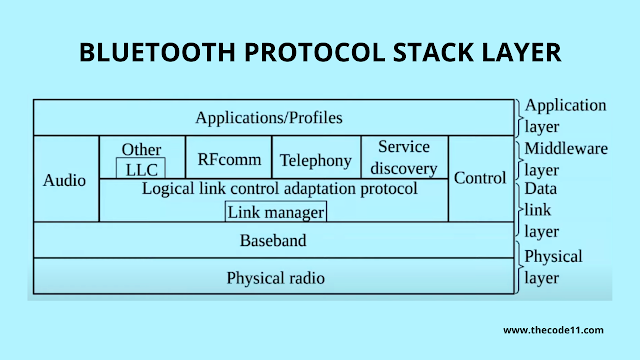In this tutorial you are going to learn about Bluetooth Protocol Stack in Computer Networks.
Introduction to Bluetooth Protocol Stack in Computer Networks
Before we go into the Bluetooth protocol stack let's discuss about the Piconet and the scatternet first. We know the basic network configuration in Bluetooth is the Piconet where we can have a master node which can cater up to seven slave nodes and group of piconet is called as the scatternet, where a master in one piconet can be a slave in another piconet. So this is the basic network configuration which we call the Piconet and the collection of piconets is called the scatternet.
Let's now see the Bluetooth protocol stack. We have various layers in Bluetooth Protocol Stack which includes physical layer, data link layer, middleware layer and finally the application layer. In this tutorial we will deal with the bottommost layer first, that is the physical layer and we will move towards the application layer.
Physical Layer/Physical Radio Layer
The physical radio layer performs modulation and demodulation of the data into radio signals. Suppose that one Bluetooth device is going to send data to another Bluetooth device so whatever it is generated in the device is the data. So those data have to be converted into radio signals. This layer converts the data into radio signals or radio waves.
Major focuses of Physical Layer: It defines the physical characteristics of Bluetooth transceivers. Transceivers means it can be a transmitter as well as a receiver because this Bluetooth adapter when it is a sender it is going to transmit and when it is a receiver it is going to receive. So that Bluetooth adapter is going to act as the transmitter as well as a receiver and that is why it is called the transceiver. It also defines two types of physical link.
Generally in computer networks we have two types of services: the connectionless services and the connection-oriented services. In connectionless services data will take any path whereas in connection oriented services data will take the predefined path.
Baseband Layer
The baseband layer or baseband link layer performs connection establishment within a piconet. We know the piconet is the basic network configuration. In a Bluetooth network if one device wants to communicate with another device if the connection has to be established between these two devices then this baseband layer is going to take care of this connection establishment within a peak on it.
Link Manager
The link manager protocol layer performs the management of already established links. It means if the connection is already established between two nodes and the management of these established links are handled by this link manager protocol or link manager layer, then this link manager layer is also concentrating on security services as well.
The services include authentication and encryption processes. Authentication means ensuring that the right entity is involved in the transactions or in the network. An encryption means suppose if one Bluetooth device is sending the data to another Bluetooth device. If it is encrypted then no other nodes can see the data that is being transmitted between the sender and the receiver. Only the sender and the receiver know what data that is being actually transmitted between them. So this layer focuses on the management part as well as the security services.
Logical Link Control Adaptation Layer
The logical link control adaptation layer or the adaptation protocol is also known as the heart of the Bluetooth protocol stack because this is going to be the interface between the upper layers and the lower layers. It allows communication between the upper and the lower layers of the Bluetooth protocol stack, so it packages the data packets received from the upper layers in the form expected by the lower layers.
This layer also performs the segmentation of multiplexing. Say from the upper layer we will get only data and these data have to be converted into the form which the lower layers can understand. So this conversion is taken care of by this logical link control and adaptation layer.
Segmentation means that if Big Data is generated by the application layer then it cannot be sent as a single stretch. We know Bluetooth is suffering from lower data rate so it has to be broken into pieces which we normally call as segments. So the segmentation part is taken care of by this layer. Also when the channel is used by many nodes at the same time then multiplexing is taken care of by this part only.
RF Comm Layer
The RF comm layer is the short form of radio front-end component. It provides a serial interface with WAP and OBEX. WAP means wireless application protocol and OBEX means it is object exchange.
TCS Layer
TCS is the telephony control protocol layer which is used for doing telephony services. We can use Bluetooth devices for voice services, fax services or even data services so this layer is responsible for dealing with that.
SDP Layer
SDP means the service discovery protocol. It allows you to discover the services available on another Bluetooth enabled device. So in a Bluetooth enabled device if you want to know what are the services that are running so this layer is responsible for dealing with that.
Application Layer
In the applications or profile layer there are some profiles or applications that are predefined. These applications are going to have the complete suite of protocols and this is the layer that is actually going to interact with the application. We have a few parts for audio communication and control related activities which are done by this layer.
This article on Bluetooth Protocol Stack in Computer Networks is contributed by Rajnish Kumar. If you like TheCode11 and would like to contribute, you can also write your article to us. Here is our mail id - thecode11info@gmail.com


